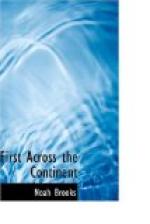Just below this stand the party met Indians who traded with tribes living near the great falls of the Columbia. That place they designated as “Tum-tum,” a word that signifies the throbbing of the heart. One of these Indians had a sailor’s jacket, and others had a blue blanket and a scarlet blanket. These articles had found their way up the river from white traders on the seashore.
On the twenty-first of October the explorers discovered a considerable stream which appeared to rise in the southeast and empty into the Columbia on the left. To this stream they gave the name of Lepage for Bastien Lepage, one of the voyageurs accompanying the party. The watercourse, however, is now known as John Day’s River. John Day was a mighty hunter and backwoodsman from Kentucky who went across the continent, six years later, with a party bound for Astoria, on the Columbia. From the rapids below the John Day River the Lewis and Clark party caught their first sight of Mount Hood, a famous peak of the Cascade range of mountains, looming up in the southwest, eleven thousand two hundred and twenty-five feet high. Next day they passed the mouth of another river entering the Columbia from the south and called by the Indians the Towahnahiooks, but known to modern geography as the Des Chutes, one of the largest southern tributaries of the Columbia. Five miles below the mouth of this stream the party camped. Near them was a party of Indians engaged in drying and packing salmon. Their method of doing this is thus described:—
“The manner of doing this is by first opening the fish and exposing it to the sun on scaffolds. When it is sufficiently dried it is pounded between two stones till it is pulverized, and is then placed in a basket about two feet long and one in diameter, neatly made of grass and rushes, and lined with the skin of a salmon stretched and dried for the purpose. Here the fish are pressed down as hard as possible, and the top is covered with fish-skins, which are secured by cords through the holes of the basket. These baskets are then placed in some dry situation, the corded part upward, seven being usually placed as close as they can be put together, and five on




